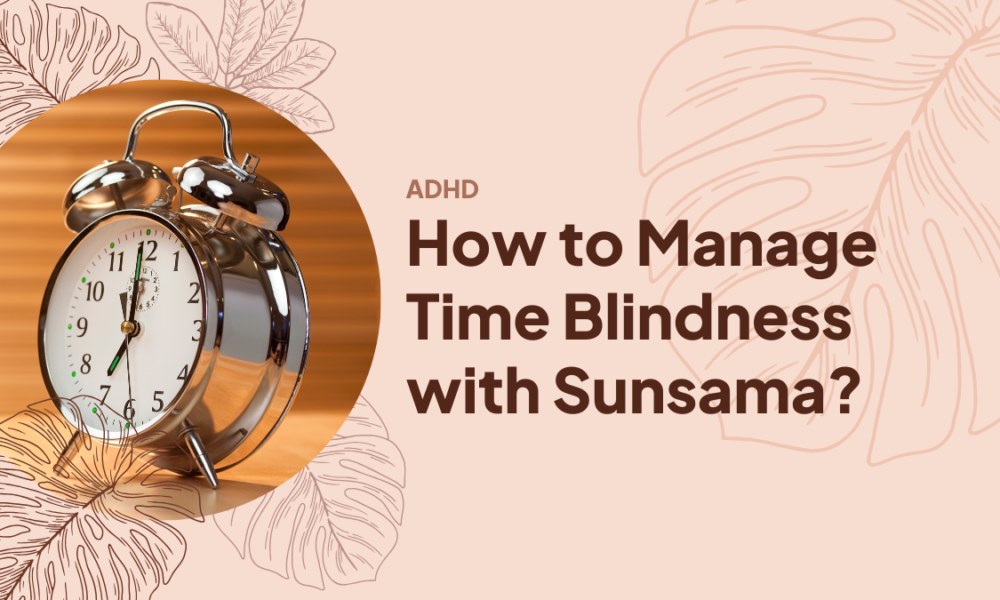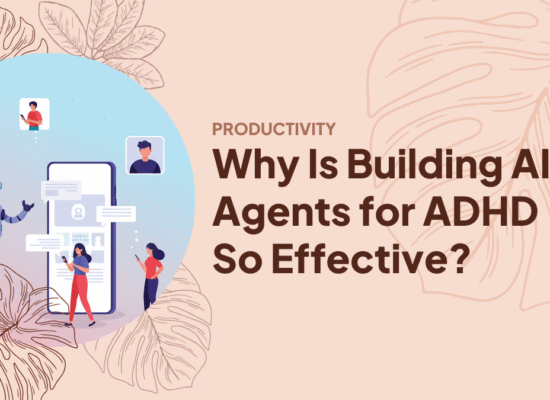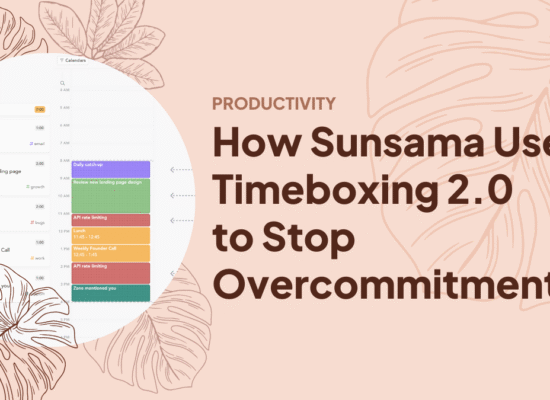Table of Contents
Time slips away. Minutes blur into hours. Suddenly the day vanishes, tasks unfinished, deadlines looming closer than they appeared. If this sounds familiar, you might need effective strategies to manage time blindness.
For many of us, especially those with adult ADHD or other neurodivergent traits, time isn’t just a measurement but a persistent challenge. We struggle to estimate how long tasks will take, misjudge available time, and find ourselves constantly running behind despite our best intentions.
The good news? Tools exist that can help us externalize our time perception and create structure where our internal clocks fail us. Sunsama stands out as particularly effective for those battling time blindness, offering a thoughtful approach to daily planning that addresses many common time perception challenges.
Understanding Time Blindness
Before diving into solutions, let’s clarify what we’re dealing with. Time blindness isn’t simply poor time management or procrastination. It’s a genuine perceptual difference where your brain struggles to accurately sense the passage of time or make realistic time-based judgments.
Common symptoms include:
- Consistently underestimating how long tasks will take
- Feeling shocked when deadlines arrive “suddenly”
- Difficulty transitioning between activities
- Getting hyperfocused on tasks to the point of losing track of hours
- Struggling to plan realistic daily schedules
- Finding it hard to prioritize tasks based on time constraints
While time blindness often accompanies adult ADHD, many neurotypical people experience it too, especially in our notification-saturated digital landscape that fragments attention and disrupts our natural time sense.
Why Sunsama Works for Time Blindness
Sunsama isn’t just another task manager. Its thoughtful design philosophy addresses several key challenges for those with time perception difficulties:
First, it creates a daily ritual of planning rather than an endless task list. This daily reset helps prevent overwhelm and forces regular reconnection with time reality.
Second, it integrates calendar blocking with task management, making time visible and concrete rather than abstract.
Third, it limits daily tasks, creating natural boundaries that prevent the common time-blind tendency to overcommit.
Fourth, it provides visual cues about task duration and day capacity, externally representing what our internal clocks struggle to track.
Best Practices for Managing Time Blindness with Sunsama

1. Start With a Daily Planning Ritual
The most powerful feature of Sunsama for ADHD brains is the daily planning ritual. Rather than treating this as a quick checkbox, invest fully in this process:
Begin each morning by reviewing your calendar commitments first. This grounds you in the reality of your available time before adding tasks.
Next, thoughtfully choose tasks from your channels and backlog. Be ruthlessly realistic about what fits in the remaining hours. If you consistently overestimate what you can accomplish, try cutting your initial list in half.
Finally, arrange tasks in your day with buffer time between them. Time blindness often means transitions take longer than we expect.
This ritual becomes an external substitute for internal time perception, creating a daily reset that prevents the cumulative disaster of continued time misjudgment.
2. Implement Time Blocking Religiously
For the time-blind brain, abstract time remains slippery and hard to grasp. Sunsama’s calendar integration transforms time from abstract to concrete:
Assign every task to a specific time block. This creates visual boundaries that make time tangible.
Include transition periods between tasks. A 15-minute buffer between activities acknowledges the reality that switching contexts requires time.
Block personal maintenance too. Time blindness often leads to forgetting basics like meals or breaks. Block these as non-negotiable appointments for proper ADHD self care.
When unexpected tasks arise, physically move other blocks to accommodate them. This creates awareness of the time trade-offs that our brains might otherwise ignore.
3. Use Duration Estimates Strategically
Time estimation is particularly challenging with time blindness, but Sunsama offers tools to improve this skill:
Start by overestimating task duration. If you think something will take 30 minutes, schedule 45 or even 60 until you calibrate your internal clock.
Track actual completion times. Sunsama allows you to record how long tasks actually took, creating valuable data to improve future estimates.
Break ambiguous projects into concrete steps. “Work on website” might take anywhere from 20 minutes to 8 hours. “Choose color palette for website header” has clearer boundaries.
Review estimation accuracy weekly. Look for patterns in your under or overestimation to gradually improve your time sense.
4. Leverage Visual Capacity Indicators
Sunsama provides visual feedback about your day’s capacity, crucial for those who struggle to intuitively sense when they’ve planned too much:
Pay attention to the time capacity bar. When it turns yellow or red, take it seriously as an external warning system your internal clock might miss.
Establish personal daily hour limits. Most productive knowledge work maxes out at 5-6 focused hours daily. Plan accordingly.
Consider energy levels alongside time. Sunsama allows task categorization, which can help distribute high-energy tasks when you’re most alert.
Use the “tomorrow” function liberally. When your day fills up, immediately move lower-priority tasks to tomorrow rather than attempting the impossible.
5. Create Externalized Transitions and Reminders
Time blindness often manifests as difficulty transitioning between activities or remembering time-based commitments:
Set up Sunsama notifications for calendar events and task transitions. These external interruptions compensate for internal time tracking challenges.
Use the “starting soon” alerts as transition signals. When a notification appears, begin wrapping up your current activity rather than trying to finish it completely.
Schedule regular check-in moments. Even with a well-planned Sunsama day, time-blind individuals benefit from scheduled reality checks to reconnect with the clock.
Consider physical timers alongside digital tools. The visual countdown of a kitchen timer or Time Timer can provide additional sensory feedback about passing time.
6. Build in Reflection and Calibration
Improving time blindness requires regular feedback loops:
Use Sunsama’s daily reflection feature faithfully. Note which tasks took longer than expected and why.
Review weekly patterns. Look for consistent time estimation errors or particular types of tasks that throw off your schedule.
Celebrate improvements in time awareness. Notice when you successfully judged task duration or maintained schedule boundaries.
Adjust gradually rather than drastically. Time perception improves slowly through consistent external structure and feedback.
Implementation Strategy
Transforming how you relate to time requires more than just installing an app. Here’s a practical implementation approach for Sunsama for ADHD brains:
Week 1: Focus solely on the daily planning ritual. Keep task lists minimal while you establish the habit of realistic daily planning.
Week 2: Implement time blocking for all tasks, with generous buffer time between activities.
Week 3: Begin tracking task duration estimates versus actuals, without judgment.
Week 4: Review your data and patterns, making initial adjustments to planning based on what you’ve learned.
Ongoing: Continue the cycle of planning, tracking, reflecting, and adjusting. Time blindness doesn’t disappear, but with external structure, its impact diminishes.
When Sunsama Isn’t Enough
While Sunsama provides excellent structure, severe time blindness might require additional supports:
Consider body-based time cues. Scheduled movement breaks, meals, or even different work locations for different parts of the day create physical anchors for time.
Explore accountability partnerships. External check-ins provide additional structure when internal time sense fails.
Investigate adult ADHD coaching or therapy if time blindness significantly impacts your life quality.
Remember that tools support strategies, but strategies emerge from understanding. The more you learn about your particular time blindness patterns, the more effectively you can adapt tools to address them.
The Realistic Path Forward
Managing time blindness isn’t about achieving perfect time perception. It’s about creating compassionate external structures that compensate for a genuine cognitive difference.
Sunsama offers a thoughtful framework that makes time visible, boundaries clear, and planning realistic. By implementing these best practices consistently, you create an external time sense that gradually influences your internal perception.
The goal isn’t becoming someone who intuitively tracks minutes and hours with precision. It’s building a sustainable system that lets you navigate a time-based world successfully despite perceiving time differently.
Key Takeaways:
- Daily planning rituals create external structure to compensate for internal time perception challenges.
- Time blocking with Sunsama transforms abstract time into visible, concrete chunks for better management.
- ADHD self care includes setting realistic expectations and building in buffer time between activities.
Take Control of Your Time, Take Control of Your Life
FAQs
What is time blindness?
Time blindness is a perceptual difference where your brain struggles to accurately sense time passage or make realistic time-based judgments, common in people with ADHD.
How does Sunsama help with time blindness?
Sunsama helps by making time visible through calendar integration, creating daily planning rituals, and providing visual feedback about task duration and day capacity.
Is time blindness only associated with ADHD?
While common in ADHD, time blindness can affect neurotypical people too, especially in our notification-saturated digital environment that fragments attention.
Maria is an accomplished digital marketing professional, specializing in content marketing and SEO. She's a neurodivergent who strives to raise awareness, and overcome the stigma that envelopes around mental health.






